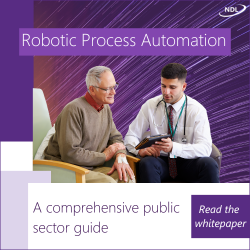
Cllr Neil Prior, deputy chair of the Local Government Association’s Improvement and Innovation Board, provides details of a new resource to make digitalisation more accessible
The Local Government Digitalisation Almanac is a new resource from the Local Government Association.
It expands on 12 digitalisation outcomes conceived last year by the LGA, the Society for Innovation, Technology and Modernisation (Socitm) and the Society of Local Authority Chief Executives (Solace) to support councils in delivering the best possible local services, growth and opportunities, with digital at the heart.
The almanac aims to make the topic of digitalisation – leveraging data and technology – more accessible and understandable to a range of users from all backgrounds, including officers and councillors with and without digital remits. It is filled with simple steps, practical examples and recommended reading to support councils pushing forward with their digital journeys.
The almanac looks at outcomes – the reasons why councils invest in digital – identifying 12 at a strategic level: connectivity, data, democracy and participation, ethics and sustainability, inclusion, leadership, economic productivity and growth, organisational capability, partnership, security and resilience, services, and value. The thinking is that clarity of outcomes increases the likelihood of achieving them.
The LGA commissioned consultants Public to expand on its early framework and explore each outcome in more depth – what each area means, the steps to take to understand more about each goal, and notable examples from authorities to consider in one’s own local context.
Integration-outcomes gap
It saw a gap of understanding between the integration of digital technology into all areas of council business and the desired outcomes of the sector’s digital efforts. There is a wealth of information about digitalisation, but not necessarily focused on local government.
In response to this, rather than being an instruction manual, the almanac contains pointers to help initiate wider conversations and prompt collaborative efforts within councils. It does so with clear language and by demonstrating that councils are part of a wider community working towards collective goals.
There are no quantifiable targets, instead issues to consider in order to push boundaries to achieve better results. This is aimed at helping councils enjoy the full benefits of digitalisation for staff, residents, businesses and communities; while they are, of course, free to think broadly and creatively about how to achieve their digitalisation goals.
The LGA has aligned the end goals of digitalisation, while making suggestions on the means. Without this alignment the sector may find itself slowed down or at cross-purposes. The almanac outlines the destination based on feedback from councils and other subject matter experts.
Greater clarity and alignment on the outcomes of digitalisation can push local government to meet citizens’ needs in new and different ways. The LGA focuses in its publication on accessibility by explaining topics in easy-to-understand ways, clarity by outlining what is achievable through leveraging data and technology, and synergy by pointing to the areas where the sector, singly and in partnership, is working to the same goal.
Several goals
Through its outcomes based approach, the LGA aims to: drive alignment and collective action on a set of urgent issues such as inclusion, ethics and sustainability; promote shared ways of working to support the sector in learning faster through reflection; motivate councils through case studies to help achieve more impact; and provide challenge as a means of continuous improvement.
The almanac has been published in response to the rapidly evolving digital landscape which is changing the ways councils work and what is expected of them. Councils will have their own drivers for digitalisation – from reducing costs or responding to population change – that are pushing the use of data, digital and technology solutions in new and different ways. The challenge of this environment is to build a shared understanding of how to improve and support local government digital programmes.
As an annual snapshot, the almanac adds to the sector’s ability to share practice, communicate effectively and build partnerships. And while the outcomes may remain stable, the LGA aims to review and refresh the publication to ensure it stays relevant and responds to changes and challenges. It is part of an ongoing conversation and is open to revision as the context evolves.
Designing and delivering modern public services requires transformation from within councils and across the sector – and the almanac presents 12 outcomes to support councils as they champion and respond to the needs of their communities.
The agreed language and shared strategic aims help take digitalisation to the next level; strengthening the sector’s position to engage across local and central government, and ultimately deliver digital services to citizens more effectively.





